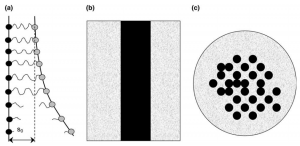Béton anisotropes : impression 3D de béton avec fibres longues, process, caractérisation et modélisation
Advisors: Jean-François Caron (NAVIER), Michel Bornert (NAVIER), Camille Chateau (NAVIER), François Toutlemonde (IFSTTAR), Nicolas Roussel (NAVIER)
Summary:
Using fibers to reinforced concrete is quite classical but using long and oriented fibres is more innovating. Some attempts may be quoted, as the replacement of steel rebars with composite pultruded profile or the embedding of fiber glass fabrics (Aachen University) for instance. But it remains localized reinforcement solutions and not a real mineral version of FRP (Fiber Reinforced Plastics). The present proposal wants to investigate the opportunity and the relevance of anisotropic concretes, since 3D printing and robots today radically change the process possibilities. Numerous experimentations, in China, United States and in France (Democrite project: XtreeE/HAL robotics/ENSAM Paris/Lafarge), aims to develop robotic 3D printing for large concrete structures. But the poor tension strength property of concrete represents a great weakness for this new printed material as a structural solution (and incompatible with Eurocodes and standards). It requires finding new technical solutions to get further with this technology. The proposed PhD focuses on the process and the characterization of an anisotropic concrete, integrating a high density of fibers, and compatible with the 3D printing technology. After a bibliography stage, a device permitting the realization of small highly reinforced specimens have to be worked out. The nature and dimensions of the chosen fibers are not yet defined, glass, basalt, metallic fibers are good challengers. Several solutions will be tried, wet or dry mixing, injection, infusion, vaccum assistance… Observations with microscope and microtomograph will be led, chemical analysis and nano-indentations tests conducted. Mechanical tests (drop test as for CFRP…) will also help to qualify the microstructure and the interfacial properties between cement and fibers. The most important parameters should be then identified (fiber nature, rugosity, cement composition and granulometry, control parameters as injection pressure….) and the improvement of the solution conducted. As soon as possible, bigger specimens will be elaborated to permit conventional mechanical tests, compression, bending, direct tension and shear. At this scale, a first sketch about the ideas and solutions may be judged, and mechanical models proposed. Multiscale approaches will try to integrate the complexity of this new material, elastic aspects but also failures and damages.

Figure 1:– a) Echelle moléculaire b) Echelle micro c) Echelle méso [Zandarov et Mader, 2005]
The first months have been used to understand the main aspect and identify possible contribution of the thesis through bibliography study. The aimed material seems more similar to fiber reinforced brittle matrix composite as SIC-SIC composites than conventional short fiber reinforced structure. In those composites as in composites in general, interface between fiber and matrix plays a main role of the global behavior (especially in the non-linear part). However, the interface behavior is particularly difficult to take into account and often needs important numerical development, with all the problem that it carries, to obtain precise microscale behavior of the material. This aspect has been particularly studied dealing with the fact that 3D printing process potentially allows a great
modularity in the material architecture (fiber contents, fibers pattern in transversal section). And to make full use of that modularity, simple designing tools taking into account microstructure are needed. the interface behavior is then the first aspect that we decided to study as it could also be a great way to differentiate different matrix/fiber couple.
Across localized crack, shear stress is a key aspect as recovery length needed to reload longitudinal stress depends directly on it. This aspect is essential as it permits to consider the possibility to obtain a structural “plasticity” created by many layer of cracks in the structure.
Contrary to what first comes to mind, the strongest interface is not necessarily the best, especially for brittle and stiff matrix composite. Optimization of this parameters depends clearly on the used material and on the aimed application. This would be an important part of thesis work to identify what a “good” interface is.
Indeed, fiber transversal pattern and elastic properties of components would completely change the interfacial stress distribution across localized rupture in the brittle matrix or more rarely in fibers. Additionally, the interfacial stress distribution could be elastic but also become inelastic in debonded area when elastic limit is exceeded. And this will change radically change the recovery length.
Then, the interfacial stress distribution is a key aspect of the behavior of the composite and depends on many parameters:
- Elastic modulus of fiber and matrix
- Interfacial Strength (shear stress, eventually lift-off stress)
- Fiber pattern in transversal section
A theoretical model has been developed based on the classical shear-lag model as a designing tool that gives account of all previous parameters and provides the 3D stress field in a one fiber reinforced micro composite with and without debonding area. That should permit to better understand the interface property of each couple fiber/matrix and a primary idea on the best fibers pattern and density but also the range of uses width for each couple.
Experimental part on micro composite that has just been launched should permit to adjust the model parameters and determine most promising couples. Moreover, many process for the production of the specimen are developed:
- Injection of mortar (adapted for medium size specimen)
- Extrusion of mortar
- Machining from macro sample to micro sample
Publications:
Natalia Kotelnikova-Weiler, Olivier Baverel, Nicolas Ducoulombier, Jean-François Caron, Progressive damage of a unidirectional composite with a viscoelastic matrix, observations and modelling, Composite Structures, 188, 297-312 (2018). DOI: 10.1016/j.compstruct.2017.12.067.
